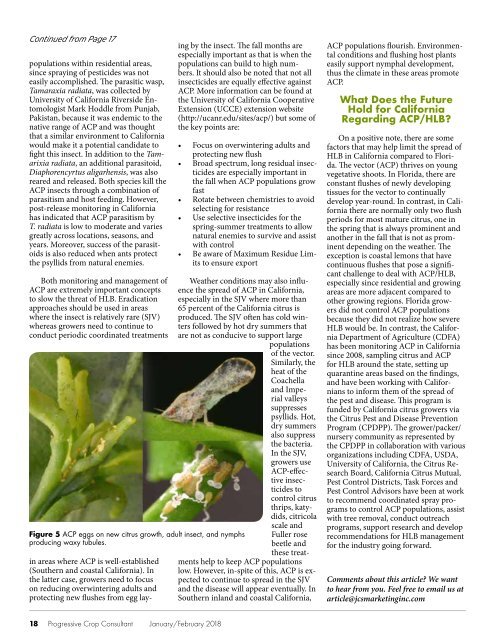You also want an ePaper? Increase the reach of your titles
YUMPU automatically turns print PDFs into web optimized ePapers that Google loves.
Continued from Page 17<br />
populations within residential areas,<br />
since spraying of pesticides was not<br />
easily accomplished. The parasitic wasp,<br />
Tamaraxia radiata, was collected by<br />
University of California Riverside Entomologist<br />
Mark Hoddle from Punjab,<br />
Pakistan, because it was endemic to the<br />
native range of ACP and was thought<br />
that a similar environment to California<br />
would make it a potential candidate to<br />
fight this insect. In addition to the Tamarixia<br />
radiata, an additional parasitoid,<br />
Diaphorencyrtus aligarhensis, was also<br />
reared and released. Both species kill the<br />
ACP insects through a combination of<br />
parasitism and host feeding. However,<br />
post-release monitoring in California<br />
has indicated that ACP parasitism by<br />
T. radiata is low to moderate and varies<br />
greatly across locations, seasons, and<br />
years. Moreover, success of the parasitoids<br />
is also reduced when ants protect<br />
the psyllids from natural enemies.<br />
Both monitoring and management of<br />
ACP are extremely important concepts<br />
to slow the threat of HLB. Eradication<br />
approaches should be used in areas<br />
where the insect is relatively rare (SJV)<br />
whereas growers need to continue to<br />
conduct periodic coordinated treatments<br />
Figure 5 ACP eggs on new citrus growth, adult insect, and nymphs<br />
producing waxy tubules.<br />
in areas where ACP is well-established<br />
(Southern and coastal California). In<br />
the latter case, growers need to focus<br />
on reducing overwintering adults and<br />
protecting new flushes from egg laying<br />
by the insect. The fall months are<br />
especially important as that is when the<br />
populations can build to high numbers.<br />
It should also be noted that not all<br />
insecticides are equally effective against<br />
ACP. More information can be found at<br />
the University of California Cooperative<br />
Extension (UCCE) extension website<br />
(http://ucanr.edu/sites/acp/) but some of<br />
the key points are:<br />
• Focus on overwintering adults and<br />
protecting new flush<br />
• Broad spectrum, long residual insecticides<br />
are especially important in<br />
the fall when ACP populations grow<br />
fast<br />
• Rotate between chemistries to avoid<br />
selecting for resistance<br />
• Use selective insecticides for the<br />
spring-summer treatments to allow<br />
natural enemies to survive and assist<br />
with control<br />
• Be aware of Maximum Residue Limits<br />
to ensure export<br />
Weather conditions may also influence<br />
the spread of ACP in California,<br />
especially in the SJV where more than<br />
65 percent of the California citrus is<br />
produced. The SJV often has cold winters<br />
followed by hot dry summers that<br />
are not as conducive to support large<br />
populations<br />
of the vector.<br />
Similarly, the<br />
heat of the<br />
Coachella<br />
and Imperial<br />
valleys<br />
suppresses<br />
psyllids. Hot,<br />
dry summers<br />
also suppress<br />
the bacteria.<br />
In the SJV,<br />
growers use<br />
ACP-effective<br />
insecticides<br />
to<br />
control citrus<br />
thrips, katydids,<br />
citricola<br />
scale and<br />
Fuller rose<br />
beetle and<br />
these treatments<br />
help to keep ACP populations<br />
low. However, in-spite of this, ACP is expected<br />
to continue to spread in the SJV<br />
and the disease will appear eventually. In<br />
Southern inland and coastal California,<br />
ACP populations flourish. Environmental<br />
conditions and flushing host plants<br />
easily support nymphal development,<br />
thus the climate in these areas promote<br />
ACP.<br />
What Does the Future<br />
Hold for California<br />
Regarding ACP/HLB?<br />
On a positive note, there are some<br />
factors that may help limit the spread of<br />
HLB in California compared to Florida.<br />
The vector (ACP) thrives on young<br />
vegetative shoots. In Florida, there are<br />
constant flushes of newly developing<br />
tissues for the vector to continually<br />
develop year-round. In contrast, in California<br />
there are normally only two flush<br />
periods for most mature citrus, one in<br />
the spring that is always prominent and<br />
another in the fall that is not as prominent<br />
depending on the weather. The<br />
exception is coastal lemons that have<br />
continuous flushes that pose a significant<br />
challenge to deal with ACP/HLB,<br />
especially since residential and growing<br />
areas are more adjacent compared to<br />
other growing regions. Florida growers<br />
did not control ACP populations<br />
because they did not realize how severe<br />
HLB would be. In contrast, the California<br />
Department of Agriculture (CDFA)<br />
has been monitoring ACP in California<br />
since 2008, sampling citrus and ACP<br />
for HLB around the state, setting up<br />
quarantine areas based on the findings,<br />
and have been working with Californians<br />
to inform them of the spread of<br />
the pest and disease. This program is<br />
funded by California citrus growers via<br />
the Citrus Pest and Disease Prevention<br />
Program (CPDPP). The grower/packer/<br />
nursery community as represented by<br />
the CPDPP in collaboration with various<br />
organizations including CDFA, USDA,<br />
University of California, the Citrus Research<br />
Board, California Citrus Mutual,<br />
Pest Control Districts, Task Forces and<br />
Pest Control Advisors have been at work<br />
to recommend coordinated spray programs<br />
to control ACP populations, assist<br />
with tree removal, conduct outreach<br />
programs, support research and develop<br />
recommendations for HLB management<br />
for the industry going forward.<br />
Comments about this article? We want<br />
to hear from you. Feel free to email us at<br />
article@jcsmarketinginc.com<br />
18 Progressive Crop Consultant <strong>January</strong>/<strong>February</strong> <strong>2018</strong>


















